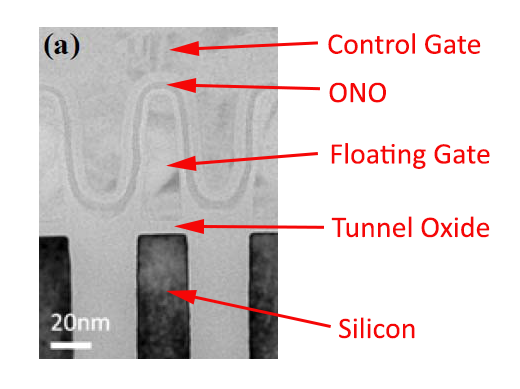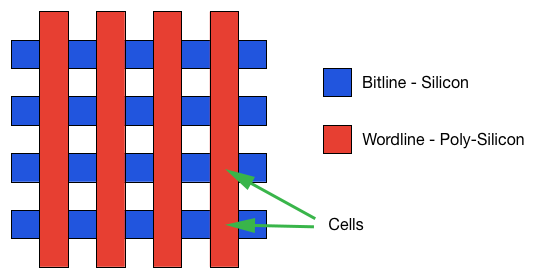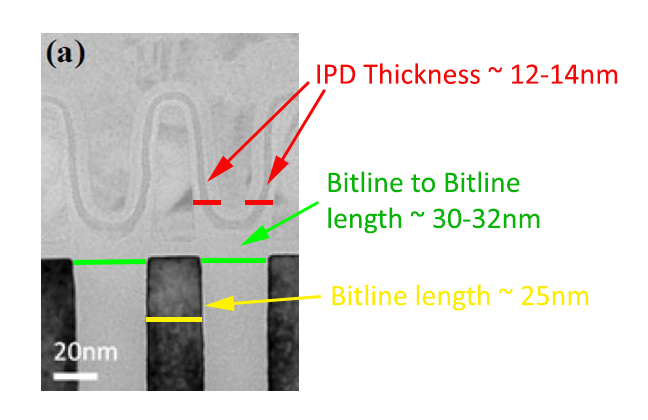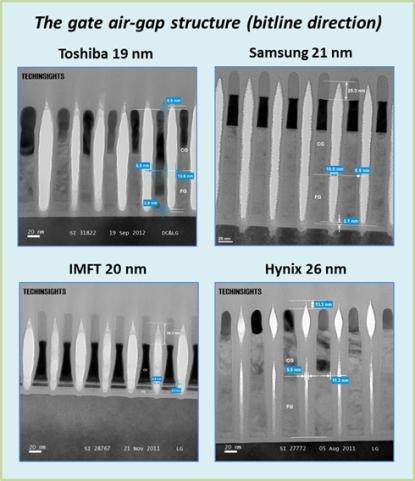Plextor M6S & M6M (256GB) Review
by Kristian Vättö on April 10, 2014 6:00 AM ESTThe Math of Marketing: Not All 19nm NAND Is the Same
Almost a year ago, Toshiba/SanDisk announced their second generation 19nm NAND. It's typical for NAND manufacturers to use the same process node for more than one generation because manufacturers can cut the die size by increasing either the page, block, or die capacity (or even all three at once), which will lead to lower production costs. However, Toshiba/SanDisk had already upped the page size to 16KB and the die capacity remained at 64Gbit, so how did they manage to decrease the die size by 17%? We'll need to dig a little deeper into the die to find that out but first (no, I'm not gonna take a selfie) let's quickly revise how NAND works.
That is what a cross-section of a NAND cell looks like when it's turned into nice colorful graph. This is what it looks like in practice:
Not as nice as the graph above, right? The reason we need the cross-section photo is because the graph is a bit too simplified and doesn't show one crucial thing: the control gate isn't something that just sits on top of the floating gate and the inter poly dielectric - it actually wraps around the whole floating gate. That's to keep the capacitance between the control and floating gates as high as possible, which in turn helps to maintain the charge in the floating gate and increase performance (the math behind this is actually more simple than you would expect but I'm not going to scare people off with a bunch of equations here). B ut that is just one cell. To truly understand the structure of NAND, we need to zoom out a bit.
That is what a bunch of NAND cells look like from above. The bitlines (i.e. silicon in the cross-section photo above) are made of silicon and on top of them are the wordlines that are also known as control gates. At every intersection of a bitline and wordline, there is one cell capable of holding one (SLC), two (MLC) or three (TLC) bits of data.
Traditionally cells are symmetrical. The process node refers to the size of one cell, so in the case of 20nm NAND, the cell size would be 20nm x 20nm. However, there is no rule against making an asymmetrical cell and that is in fact what Toshiba/SanDisk did with their first generation 19nm NAND. Instead of being a symmetrical 19nm x 19nm design, the cell size was 19nm x 26nm. Compared to IMFT's symmetrical 20nm design, the actual cell size is quite a bit larger (494 nm2 vs 400 nm2 ), yet in terms of marketing Toshiba's/SanDisk's "19nm" NAND was smaller and more advanced.
You could call that cheating but there is a good technical reason as to why building an asymmetrical design makes sense. As I mentioned earlier, the wordline (control gate) wraps around every floating gate and between them is an insulating inter poly dielectric (often referred to as ONO due to its oxide-nitride-oxide structure, or just IPD). Since the floating gate is where the electrons are stored, it needs to be insulated; otherwise the electrons could easily escape the floating gate and you would have a brick that can't reliably hold data.
The inter poly dielectric (IPD) is the tricky part here -- because it wraps around every floating gate, the minimum distance between two floating gates (and hence bitlines) must be at least twice the thickness of the IPD. Scaling the IPD is difficult because if you make it too thin, the cell becomes vulnerable to leakage because the IPD won't be able to reliably insulate the floating gate. Generally it's considered impossible to scale the IPD below 10nm, so 26nm is already pretty good and 20nm is hitting the limits.
IMFT's approach is different. It's a high-k metal gate design and the wordline no longer needs to be wrapped around the floating gate, but I'm not going to go into more detail about that here. The short summary is that it allows for a symmetrical 20nm design without sacrificing reliability.
Courtesy of EETimes.com
In addition, you will want to have some conducting poly-silicon (i.e. wordline/control gate) between every bitline as well to build up capacitance, so in reality it's much harder scale the bitline length compared to the wordline. There is no wrapping issue with wordlines and the only thing you really have to take into account is wordline to wordline interference. To battle that, all NAND manufacturers are currently using tiny air gaps between every wordline to reduce the interference and still be able to scale down the NAND.
| IMFT (Intel/Micron) | Toshiba/SanDisk | |||
| NAND Process | 20nm 64Gbit | 20nm 128Gbit | 19nm 64Gbit (1st gen) | A19nm 64Gbit (2nd gen) |
| Cell Size | 20nm x 20nm | 19nm x 26nm | 19nm x 19.5nm | |
| Die Size | 118mm2 | 202mm2 | 113mm2 | 94mm2 |
| Gbit per mm2 | 0.542 | 0.634 | 0.566 | 0.681 |
With the second generation 19nm NAND, Toshiba/SanDisk has been able to cut the bitline length from 26nm to 19.5nm. It's still 19nm per marketing standards but at the engineering level this is pretty significant. Unfortunately the NAND is so new that I don't know what Toshiba/SanDisk has done to achieve a 19nm x 19.5nm cell size. It's certainly possible that Toshiba/SanDisk has also transitioned to a high-k metal gate process but we'll know more when the chip is put under a microscope.
It's interesting that while IMFT's 20nm NAND has smaller cell size than Toshiba's/SanDisk's first generation 19nm die, the density is still lower. I believe this has to do with IMFT's relatively poor memory area efficiency, which is only 52% for the 20nm 64Gbit die (i.e. 52% of the die is the actual memory part; the rest is peripheral circuits like interconnects and alike).
The real question for most users will be what sort of performance you can get out of the new NAND, however, so let's move on to benchmarks with the Plextor M6S/M6M.















30 Comments
View All Comments
prime2515103 - Thursday, April 10, 2014 - link
I find it disappointing how average Plextor has become, yet they keep their pricing at a point where one might expect to get something at least slightly exceptional.I do have an M5M in my laptop and haven't had any problems with it, so I'll give them that. The selection of mSATA drives was pretty sparse when I bought it though, and it was on sale for $108 (which was quite good at the time), otherwise it definitely would not have been my first choice.
Cellar Door - Thursday, April 10, 2014 - link
I agree, I will be going with samsung evo for my msata drive. Very disappointing for the price.Samus - Thursday, April 10, 2014 - link
M500 is still the best deal for an average, reliable SSD. Great for basic business and family PC's.rufuselder - Thursday, October 9, 2014 - link
Me too. But either way, there are some much better storage options out there. /Rufus from http://www.consumertop.com/best-computer-storage-g...dylan522p - Thursday, April 10, 2014 - link
That was good basic explanation of the differences between everyones NAND! Thanks for doing that.nathanddrews - Thursday, April 10, 2014 - link
The pictures of the IMFT and Samsung processes are all clean and uniform... the Toshiba and Hynix processes look like a 3-year-old with a crayon made them.zodiacsoulmate - Thursday, April 10, 2014 - link
yea... why they look like that? maybe they are hard to color? why they look so random...extide - Thursday, April 10, 2014 - link
LOL, I noticed that too, it's like, geez how does that stuff even work! Looks so sloppy!Kristian Vättö - Friday, April 11, 2014 - link
Keep in mind that the diameter of the photo is a few dozen nanometers and it's extremely hard to achieve 100% precision with lithographies that small. At least IMFT has been using air gaps before and it's a mature process for them but Toshiba and Hynix added them to the current generation, making it quite new for them.creed3020 - Thursday, April 10, 2014 - link
Kristian thanks for such an in-depth technical and product review. I really appreciate how in your reviews graphs are accompanied with text explaining the results and providing an opinion on the results. I can read a graph but interpretation of those graphs and data trends is often missing from reviews here at AT.I am surprised that such a new drive isn't also available in M2 format but I guess they have the M6e for that. Is there a review of that drive coming as well?